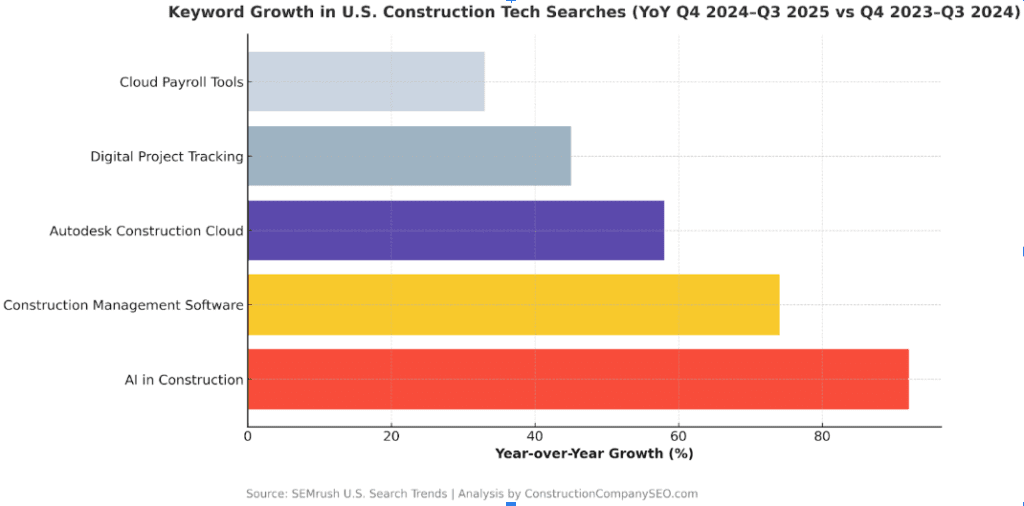The construction industry, long defined by physical labor and on-site experience, is quietly undergoing a digital revolution. What once relied on handshakes, clipboards, and decades of intuition is now powered by cloud platforms, analytics dashboards, and real-time project data.
New keyword data shows a steep rise in searches tied to technology adoption within construction — from “Autodesk Construction Cloud” and “AI in construction” to “construction management software” and “digital project tracking.” The trend reveals an unmistakable shift: America’s builders are moving from concrete to code.
Search Data Signals a Shift Toward Technology
When construction-related search behavior was analyzed across the U.S., one pattern stood out — technology keywords are climbing faster than traditional ones. While phrases like “construction companies near me” or “home builders” remain steady, queries for digital tools such as “construction cloud software” and “AI construction management” have surged more than 70% year-over-year.
This isn’t just curiosity — it’s intent. Search intent data suggests that mid-sized contractors and regional builders are actively looking for ways to digitize workflows, track jobs remotely, and eliminate inefficiencies that can cost thousands per project.
“The construction sector has quietly become one of the most data-intensive industries in America,” says Fahad Raza, founder of ConstructionCompanySEO.com. “From bids to billing, everything is measurable now. The firms that understand this shift early will own their markets by 2026.”
Why Builders Are Turning to Tech
1. Tight Margins Push Efficiency
Margins are tight. Delays are expensive. Every mistake costs real dollars. Cloud-based tools now enable builders to track job progress, predict overruns, and adjust schedules in real time.
2. Labor Shortages Drive Automation
With skilled labor in short supply, companies are turning to technology to fill the gap. Drones, AI-assisted design software, and remote supervision tools help firms do more with smaller teams.
3. Clients Expect Transparency
Homeowners and developers now expect live updates — not quarterly reports. Apps that visualize progress, budgets, and milestones have turned data transparency into a competitive advantage.
The Local Impact of Construction Tech
The digital shift isn’t confined to billion-dollar enterprises. Across the Sunbelt, Midwest, and Pacific Northwest, smaller builders are investing in accessible digital tools — online client portals, cloud scheduling systems, and AI-driven estimators that streamline day-to-day operations.
To understand where this tech adoption wave is strongest, we applied the Fery Kaszoni data-PR method — a data-normalization framework that combines keyword search volume with population data to calculate searches per 100,000 people. Using national SEMrush.com’s data for construction-tech queries and scaling it against U.S. Census proportions, the following states emerged as the most “construction-tech curious” in 2025:
| Rank | State | Estimated Searches per 100k People | Trend Insight |
| 1 | Texas | 182 | Surge in AI-assisted project management and digital bidding |
| 2 | Florida | 174 | Rising demand for cloud-based payroll and workforce tools |
| 3 | California | 166 | Strong focus on BIM integration and sustainability analytics |
| 4 | Illinois | 153 | Expanding use of remote job-tracking and reporting platforms |
| 5 | Ohio | 148 | Increased adoption of small-business CRMs and scheduling apps |
| 6 | North Carolina | 142 | Builders turning to predictive maintenance and AI estimation |
| 7 | Colorado | 138 | Growth in construction analytics and field-data platforms |
| 8 | New York | 132 | Urban contractors exploring digital compliance tools |
| 9 | Georgia | 126 | Automation replacing paperwork in local contracting |
| 10 | Washington | 118 | Early interest in cloud-based collaboration systems |
Source: SEMrush keyword data normalized by U.S. Census state populations (Q4 2024 – Q3 2025).
“When you map search intent against population, you reveal curiosity — and curiosity predicts adoption,” notes Raza. “The data shows the Sunbelt isn’t just building more; it’s building smarter.”
What Search Data Reveals About The Industry Behavior
Search data acts as an early pulse of real-world change. Over the past 12 months, searches for “construction management software” doubled, while “AI in construction” saw triple-digit growth. Even traditionally hands-on roles — estimators, project leads, site managers — are now turning to software that measures output, not effort.
As Raza explains, “What people search tells you what the industry’s thinking. Builders aren’t just building anymore; they’re analyzing. Every project is becoming a data project.”
This is where Construction Company SEO comes in — helping builders, contractors, and construction firms increase digital visibility, connect with local clients, and build credibility in a data-driven market.
Construction used to be defined by blueprints and manpower. Now it’s being redefined by data literacy — the ability to interpret numbers, forecasts, and metrics that drive better decisions. By 2030, firms leveraging automation and analytics could see up to 25% higher efficiency and 15% lower costs. The winners will be those who build not only structures, but systems.
“We’re seeing the same digital transformation curve construction faced with tools decades ago — only this time, it’s software, not steel,” says Raza. “The firms that adapt early won’t just build better projects. They’ll build better businesses.”
Author’s Bio
| I’m Fahad Raza, an SEO consultant with 18+ years of experience watching search evolve from Yahoo’s editors to today’s AI-driven algorithms. After co-founding Right Click, building KeywordProbe, and leading IKEA’s SEO strategy for 7 years, I launched ConstructionCompanySEO.com to help builders, remodelers, and contractors earn steady local jobs through stronger positioning, genuine trust, and results-driven SEO. |




































